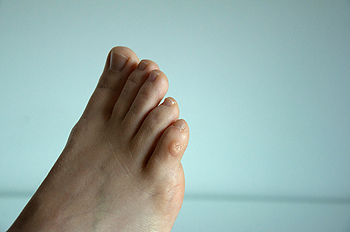
A small, hardened area of skin that has formed on the foot may indicate a corn has developed. They generally develop on the outside of the pinky toe, or on the bottom of the foot, as a result of excessive friction. This can happen from wearing shoes and socks that are too tight, and temporary relief may come from choosing to wear shoes that fit correctly. A corn on the foot can cause severe pain and discomfort, despite their small size. There are three types of corns that can develop, consisting of hard, soft, and seed corns. The former is considered to be the most common type of corn, and can develop on top or on the side of the toes. Soft corns generally develop between the toes, as a result of excess moisture that can accumulate there. The latter forms on the soles of the feet, and are generally small in size. Research has shown the best method to prevent a corn from developing is by wearing shoes that are comfortable. This is generally successful in alleviating pressure against the toes. Many people who have developed corns seek the advice of a podiatrist who can effectively remove them, and offer additional prevention techniques.
Corns can make walking very painful and should be treated immediately. If you have questions regarding your feet and ankles, contact Dr. Thomas E. Silver of Westwood Foot Clinic. Our doctor will treat your foot and ankle needs.
Corns: What Are They? And How Do You Get Rid of Them?
Corns are thickened areas on the skin that can become painful. They are caused by excessive pressure and friction on the skin. Corns press into the deeper layers of the skin and are usually round in shape.
Ways to Prevent Corns
There are many ways to get rid of painful corns such as:
- Wearing properly fitting shoes that have been measured by a professional
- Wearing shoes that are not sharply pointed or have high heels
- Wearing only shoes that offer support
Treating Corns
Although most corns slowly disappear when the friction or pressure stops, this isn’t always the case. Consult with your podiatrist to determine the best treatment option for your case of corns.
If you have any questions please feel free to contact our office located in Golden Valley, MN . We offer the newest diagnostic and treatment technologies for all your foot and ankle needs.
